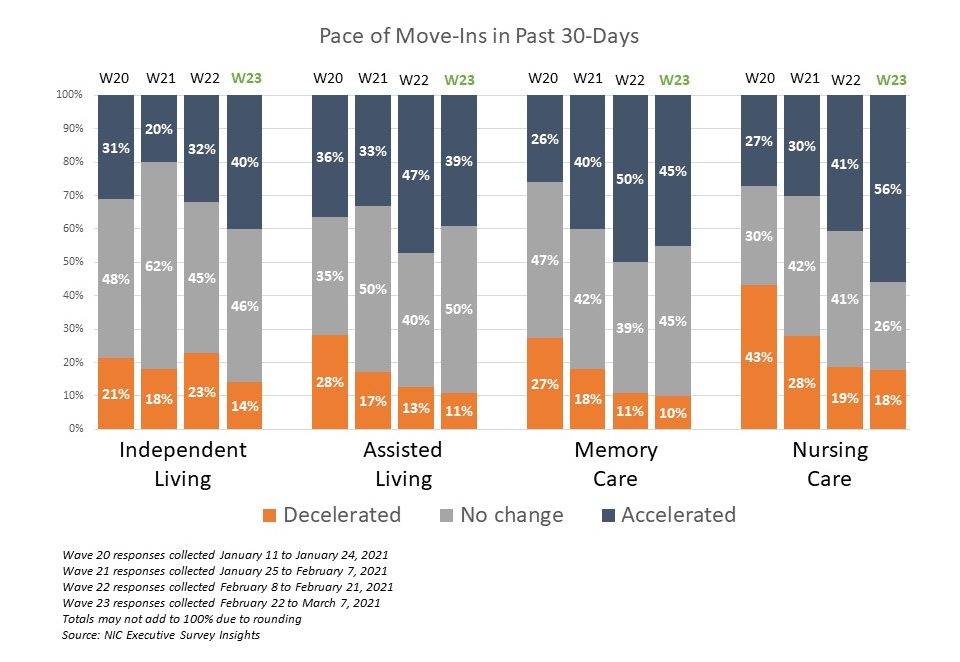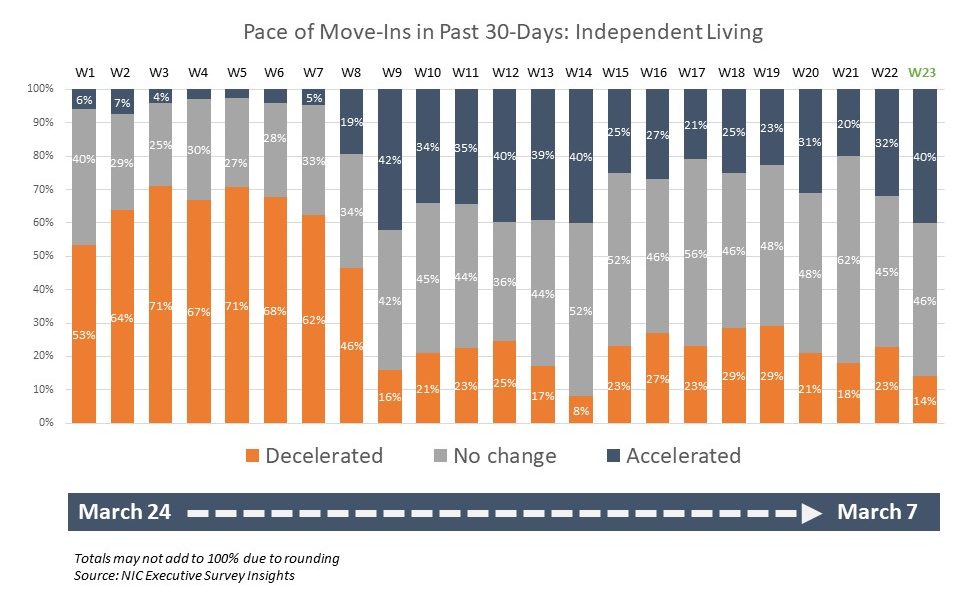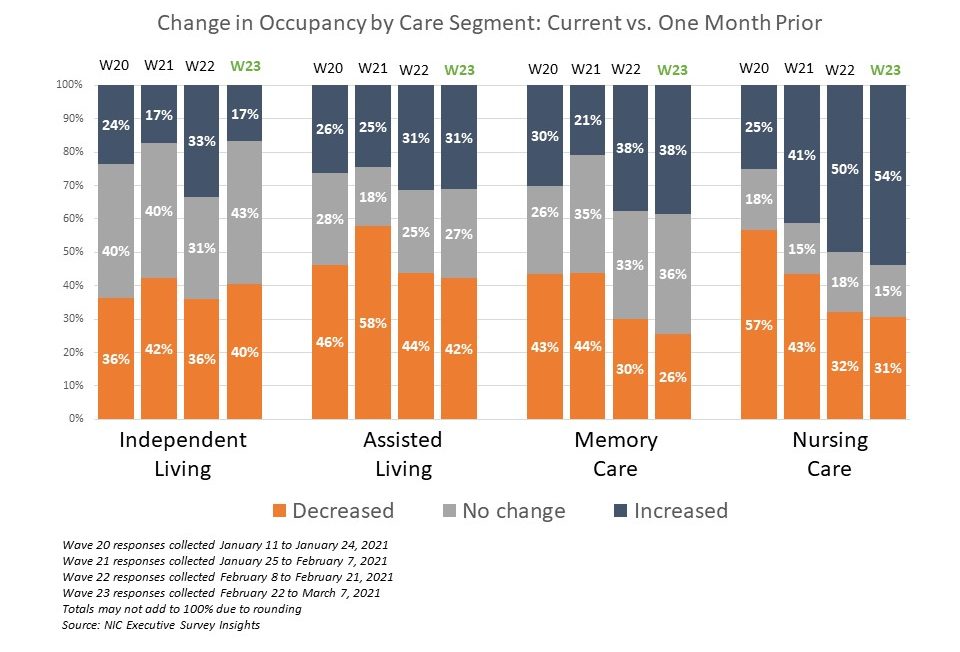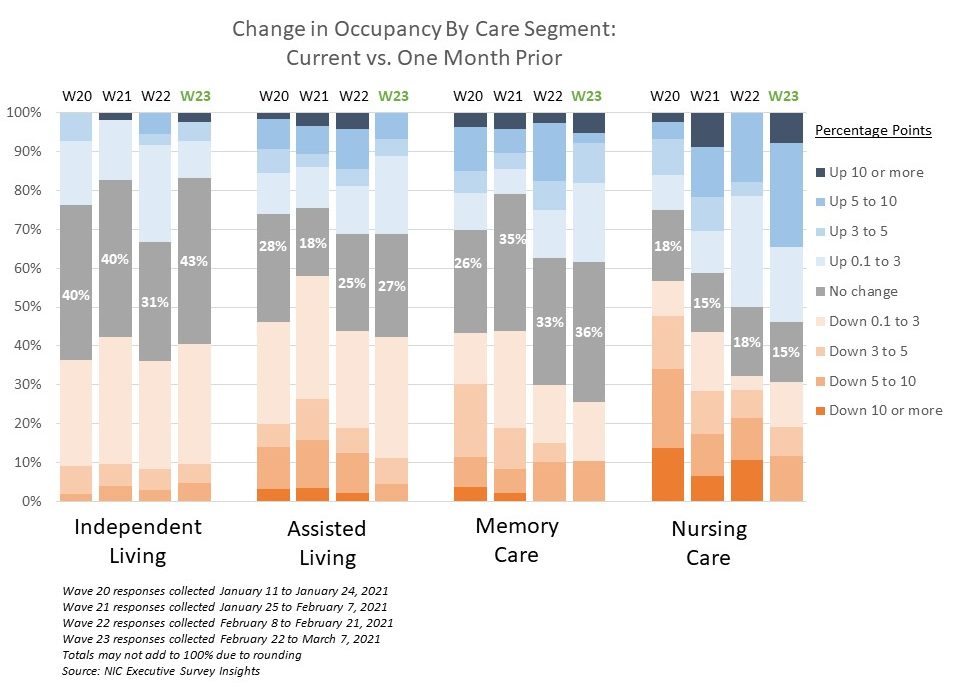“The pandemic has necessitated many changes in the way seniors housing and care operators do business. In the NIC Executive Survey Insights Wave 23 results, respondents were asked to list one of the things that their organization plans to keep doing, stop doing, bring back and further develop. In addition to maintaining COVID-19 and infection mitigation protocols, organizations will continue leveraging virtual technologies for a variety of uses including digital marketing campaigns, entertainment, remote visits, and some activities. With 80% of survey respondents’ residents fully vaccinated on average, seniors housing and care operators are looking forward to bringing back communal dining, group activities, resident/employee gatherings, and discontinuing visitation restrictions, meal delivery, pandemic staff benefits, and frequent COVID-19 testing.”
–Lana Peck, Senior Principal, NIC
NIC’s Executive Survey of operators in seniors housing and skilled nursing is designed to deliver transparency into market fundamentals in the seniors housing and care space as market conditions continue to change. This Wave 23 survey includes responses collected February 22 to March 7, 2021 from owners and executives of 69 small, medium, and large seniors housing and skilled nursing operators from across the nation, representing hundreds of buildings and thousands of units across respondents’ portfolios of properties.
Detailed reports for each “wave” of the survey and a PDF of the report charts can be found on the NIC COVID-19 Resource Center webpage under Executive Survey Insights. Additionally, the full range of time series data for each wave of the survey by care segment for move-ins, move-outs and occupancy rate changes can be found here.
Wave 23 Summary of Insights and Findings
- According to Wave 23 seniors housing and care survey respondents, roughly 80% of residents and 55% of staff of their respective properties—including all care segments across their portfolios—have been fully vaccinated. From late January to the present, resident uptake of the vaccine increased as the vaccine reached more and more residents. Staff uptake of the vaccine has, however, appeared to have leveled off. Prior surveys (Waves 21 and 22) explored the many ways organizations have promoted COVID-19 vaccinations to residents and staff. The positive impact of the vaccine on decreasing new cases and deaths relative to the total U.S. population is clearly illustrated in data compiled in NIC’s Skilled Nursing COVID-19 Tracker.

- A slim majority of organizations surveyed in Wave 23 indicate they will probably not or definitely not make the COVID-19 vaccine mandatory for staff (55%); however, one-quarter probably will or definitely will (25%). The share of organizations considering making the vaccine mandatory for staff has increased since Wave 22 (11%).

- Many operators have been eagerly anticipating a boost in occupancy due to the COVID-19 vaccine availability. One-third of organizations responding to the Wave 23 survey noted an increase in prospect interest specifically related to the vaccine—up from 25% in Wave 21. Nearly two-thirds of survey respondents (62%) expect their organizations’ occupancy rates to recover to pre-pandemic levels sometime in 2022.
- For the third successive survey wave, the shares of organizations reporting acceleration in the pace of move-ins is higher than those organizations reporting deceleration for each of the care segments. Furthermore, organizations reporting deceleration in the pace of move-ins has shrunk to time series lows in the memory care, assisted living and nursing care segments.

- Looking specifically at the independent living care segment—considered a “choice-based” move-in because of the type of and lower level of care services delivered compared to assisted living, memory care and nursing care (considered needs-based move-ins)—it is interesting to note that the pace of move-ins has also trended positively since the Wave 20 survey, reflecting operator experiences in December 2020. In Wave 23, 40% organizations with independent living units in their portfolios of properties noted acceleration in the pace of move-ins—the highest in the survey since Waves 9 through 14—surveyed late-June through the end of October.

- Although increased resident demand was cited by three-quarters of respondents (77%) as a reason for acceleration in move-ins in the past 30-days, only about one in ten respondents in the Wave 23 survey reported that their organizations had a backlog of residents waiting to move in (11%)—lower than at any other time since the question was first asked in late July. Possible reasons may include the previously mentioned trend of the pace of move-ins increasing across each of the care segments taking up some of the slack in pent-up demand, residents moving to different levels of care, the lifting of restrictions due to vaccine uptake among residents, and potentially less turnover of inventory in some properties as the pace of move-outs continued to slow in the Wave 23 survey.
- The share of organizations currently offering rent concessions remains around 50% since W12, surveyed mid- to late-September. Of those organizations with multiple properties, nearly two-thirds (64%) say they are offering rent concessions in more than 50% or all of their properties.
- The Wave 23 survey data shows a trend in the shares of organizations reporting an increase or no change in occupancy since the prior survey for the assisted living, memory care and nursing care segments. Roughly half of organizations with nursing care beds in their portfolios of properties reported higher occupancy rates from one-month prior in survey Waves 22 and 23.

- The chart above shows that in Wave 23, 54% of organizations with nursing care beds reported increasing occupancy rates in the past 30-days. As shown in the chart below, the majority of the increases were larger than reported in the Wave 22 survey. (The blue and orange-hued stacked bars correspond to the solid bars in the chart above indicating the degree of change by the saturation of color.) In the Wave 22 survey, 30% of respondents with nursing care beds reported occupancy increases of 0.1 to 3 three percentage points, however, in the Wave 23 survey, one-third (35%) reported occupancy increases of 5 percentage points or more.

- One-third of respondents—similar to the share of organizations in the Wave 10 survey—expect an increase in their development pipelines going forward (33% and 30%, respectively). It is interesting to note that organizations’ expectations have not changed much since last summer. Among those who expect their development pipelines to increase, reasons such as current and future market demand, and continuation of expansion plans prior to the pandemic, were cited most frequently.
- In the Wave 23 survey, respondents were asked to list one of the things that their organization plans to keep doing, stop doing, bring back and further develop. Respondents mentioned that their organizations would keep doing and/or further develop COVID-19 infection mitigation, and virtual technologies for entertainment, remote visits, and some activities. Others would keep doing and/or further develop employee engagement programs, and digital and social media marketing campaigns.
- Respondents are looking forward to bringing back communal dining, group activities and resident/employee gatherings, and discontinuing visitation restrictions, meal delivery, pandemic staff benefits, and COVID-19 isolation of residents, and frequent testing.

Wave 23 Survey Demographics
- Responses were collected between February 22 and March 7, 2021 from owners and executives of 69 seniors housing and skilled nursing operators from across the nation. Owner/operators with 1 to 10 properties comprise just over one-half of the sample (58%). Operators with 11 to 25 properties make up about one-quarter of the sample (23%), while operators with 26 properties or more make up 19% of the sample.
- One-half of respondents are exclusively for-profit providers (52%), one-third (33%) are nonprofit providers, and 15% operate both for-profit and nonprofit seniors housing and care organizations.
- Many respondents in the sample report operating combinations of property types. Across their entire portfolios of properties, 73% of the organizations operate seniors housing properties (IL, AL, MC), 28% operate nursing care properties, and 37% operate CCRCs (aka Life Plan Communities).
Owners and C-suite executives of seniors housing and care properties, we’re asking for your input! By demonstrating transparency, you can help build trust. The survey results and analysis are frequently referenced in media reports on the sector including in McKnight’s publications, Mortgage Professional America Magazine, Senior Housing News, Multi-Housing News, Provider Magazine, and other industry-watching media outlets. The surveys’ findings have also been mentioned in stories by Kaiser Health News, CNN, the Wall Street Journal, and other major news outlets across the U.S.
The Wave 24 survey is available and takes 5 minutes to complete. If you are an owner or C-suite executive of seniors housing and care and have not received an email invitation to take the survey, please click this link or send a message to insight@nic.org to be added to the email distribution list.
NIC wishes to thank survey respondents for their valuable input and continuing support for this effort to bring clarity and transparency into market fundamentals in the seniors housing and care space at a time where trends are continuing to change.
About Lana Peck
Lana Peck, former senior principal at the National Investment Center for Seniors Housing & Care (NIC), is a seniors housing market intelligence research professional with expertise in voice of customer analytics, product pricing and development, market segmentation, and market feasibility studies including demand analyses of greenfield developments, expansions, repositionings, and acquisition projects across the nation. Prior to joining NIC, Lana worked as director of research responsible for designing and executing seniors housing research for both for-profit and nonprofit communities, systems and national senior living trade organizations. Lana’s prior experience also includes more than a decade as senior market research analyst with one of the largest senior living owner-operators in the country. She holds a Master of Science, Business Management, a Master of Family and Consumer Sciences, Gerontology, and a professional certificate in Real Estate Finance and Development from Massachusetts Institute of Technology (MIT).
Connect with Lana Peck
Read More by Lana Peck